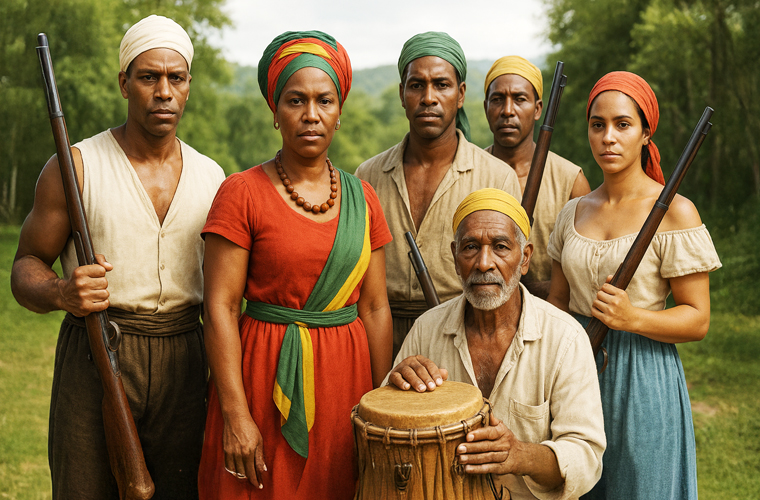The Maroons of Jamaica stand as a powerful symbol of resistance, cultural endurance, and the unyielding quest for freedom. Descended from enslaved Africans who escaped from plantations during the 17th and 18th centuries, the Maroons forged independent communities in Jamaica’s rugged interior, defying colonial oppression and creating a unique cultural legacy that endures to this day. This article explores their origins, struggles, triumphs, and lasting impact on Jamaican society and global history.
The term “Maroon” derives from the Spanish word cimarrón, meaning “wild” or “untamed.” It was initially used to describe escaped enslaved Africans who fled to remote areas to evade capture. In Jamaica, the Maroons emerged as early as the Spanish occupation (1509–1655), when enslaved Africans escaped into the island’s mountainous and forested regions. When the British seized Jamaica in 1655, many more enslaved people took advantage of the chaos to escape, joining existing Maroon communities or forming new ones.
These early Maroons were primarily from West African ethnic groups, including the Akan, Ashanti, and Coromantee peoples from the Gold Coast (modern-day Ghana). Their African heritage profoundly shaped their social structures, spiritual practices, and resistance strategies. Over time, they developed a distinct Afro-Jamaican identity, blending African traditions with adaptations to their new environment.
The Maroons’ survival depended on their ability to resist colonial forces. Jamaica’s terrain—rugged mountains, dense forests, and hidden caves—provided natural fortifications for their communities. The two primary Maroon groups were the Windward Maroons, based in the Blue Mountains in eastern Jamaica, and the Leeward Maroons, centered in the Cockpit Country in the west.
The Maroons became masters of guerrilla warfare, using their knowledge of the terrain to launch surprise attacks on British plantations and militia. They employed tactics such as ambushes, traps, and hit-and-run assaults, which frustrated British efforts to subdue them. Leaders like Nanny of the Windward Maroons and Cudjoe of the Leeward Maroons became legendary for their strategic brilliance and unyielding commitment to freedom.
Nanny, a national heroine of Jamaica, is celebrated for her leadership and spiritual influence. Oral traditions describe her as a fierce warrior and an obeah practitioner, using African spiritual practices to inspire and protect her people. Cudjoe, on the other hand, was a skilled negotiator and military tactician who unified various Maroon groups in Cockpit Country. Their leadership was pivotal during the First Maroon War (1728–1739), a prolonged conflict against British forces.
By the late 1730s, the British colonial government, unable to defeat the Maroons militarily, sought peace through negotiation. In 1739–1740, the British signed treaties with the Leeward and Windward Maroons, granting them autonomy, land, and the right to govern their communities in exchange for ceasing hostilities and assisting in capturing runaway slaves. These treaties were a remarkable achievement, making the Jamaican Maroons one of the few groups in the Americas to secure legal recognition of their freedom during the era of slavery.
The treaties, however, were not without controversy. The requirement to return runaway slaves created tensions within Maroon communities, as it conflicted with their ethos of resistance. Some Maroons adhered to the treaty terms, while others covertly aided runaways, maintaining their role as symbols of defiance.
Maroon communities developed rich cultural traditions that blended African and Jamaican elements. Their social structures were often modeled on Akan systems, with a strong emphasis on communal living, respect for elders, and matrilineal kinship in some groups. Music, dance, and storytelling were central to Maroon life, preserving African traditions while incorporating new influences. The abeng, a horn used for communication across long distances, became an iconic symbol of Maroon resilience.
Spirituality played a vital role, with practices like obeah and myal providing a framework for resistance and community cohesion. These African-derived spiritual systems empowered Maroons to maintain their cultural identity in the face of colonial oppression.
Maroon villages, such as Accompong in Cockpit Country and Moore Town in the Blue Mountains, became centers of cultural preservation. These communities developed their governance systems, blending African traditions with democratic principles, and maintained a degree of autonomy that was rare for people of African descent in the colonial era.
Despite their autonomy, the Maroons faced challenges. The Second Maroon War (1795–1796), sparked by tensions between the Trelawny Town Maroons and the British, highlighted the fragility of the treaties. The British, fearing Maroon influence on enslaved populations, exiled many Trelawny Maroons to Nova Scotia and later Sierra Leone. This event underscored the ongoing threat of colonial power, even after the treaties.
Internally, Maroon communities grappled with balancing their autonomy with external pressures. The obligation to return runaways strained relations with enslaved populations, though many Maroons continued to support resistance movements covertly.
Today, Jamaican Maroon communities, such as Accompong, Moore Town, Charles Town, and Scott’s Hall, remain vibrant centers of cultural heritage. They are recognized as Indigenous communities under Jamaican law, with rights to their ancestral lands. Annual celebrations, such as Accompong’s January 6th celebration commemorating the 1739 treaty, draw visitors and highlight Maroon music, dance, and traditions.
The Maroons’ legacy extends beyond Jamaica. Their story of resistance inspired abolitionist movements and continues to resonate in global struggles for freedom and self-determination. In 2008, the Maroon heritage of Moore Town was designated a UNESCO Masterpiece of the Oral and Intangible Heritage of Humanity, recognizing its global cultural significance.
The Maroons of Jamaica embody the indomitable spirit of resistance against oppression. From their origins as escaped enslaved Africans to their establishment of autonomous communities, they defied the odds to create a legacy of freedom, cultural pride, and resilience. Their story is a testament to the power of collective action and cultural preservation in the face of adversity. As Jamaica and the world continue to grapple with issues of justice and equality, the Maroons’ enduring legacy serves as both an inspiration and a reminder of the strength found in unity and determination.

